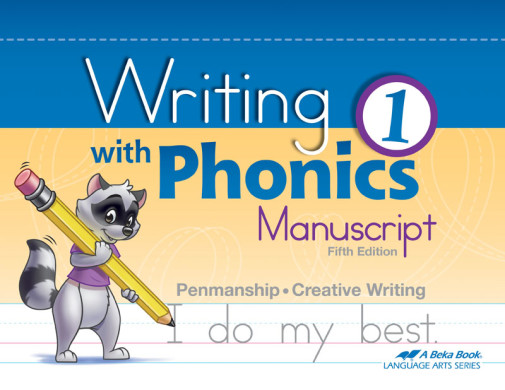We use cookies to make your experience better. To comply with the new e-Privacy directive, we need to ask for your consent to set the cookies. Learn more.
Writing with Phonics Grade 1 - Manuscript (5th Edition)
This colorful workbook has a landscape orientation with double-sided worksheets. Lines are 7/16" and, in the beginning of the book, have the familiar “handwriting" house icon. Pages have a weekly pattern of handwriting practice that includes letter stroke warm-ups, tracing, writing, and copying. Letters, letter combinations, words, and sentences reinforce the phonics instruction. Poems and Bible verses are added in as the year progresses, as well as paragraphs from writing prompts. To encourage creative writing from prompts, there are pages with lines on one side and “cover" artwork on the other. These can be folded into little booklets featuring the child's original composition. An important addition to this year's course is the 31 (weekly) handwriting tests.
For those who prefer to teach manuscript writing (printing) rather than cursive, this 255-page workbook will provide your child with the foundational skills of manuscript writing before he learns cursive writing in second grade. The formation guide gives you and your child a template to follow. Each lesson features warm up exercises as well as an example of the letter that is being practiced that day. Help your child master letter formation, size, spacing, correct posture for writing, and correct position for paper and pencil. Begins with single letters and progresses to phonics blends of more than one letter, special sounds, and words for your child to trace and copy. Phonics, spelling, and creative writing skills are built into the exercises.
These materials are graded specifically and include both instruction and practice.
Whatsoever thy hand findeth to do, do it with thy might. Ecclesiastes 9:10 Abeka's approach to handwriting/penmanship is unique in a few major ways. First, is their commitment to cursive handwriting from the earliest levels. A preference for cursive handwriting (an extension of the natural tendency of children to draw in loops) marks their K4 and K5 materials. Although they do offer a manuscript option in terms of books and curriculum plans, still it is cursive that is incorporated into their overall lesson plans. And, cursive is the only handwriting option after 1st grade.
Second, is their coverage of composition practice in the penmanship materials. Combining penmanship instruction/practice with composition practice might seem logical, but it is rarely found in curriculum. Abeka's handwriting program is an exception. Although the earliest years of handwriting instruction/practice are correlated with letter/sound instruction, that begins to change toward the end of the 1st grade materials when paragraph composition is introduced. Paragraph writing and writing prompts are woven throughout the Grade 2 materials. Starting with Grade 3, composition and creative writing become a central focus, although the materials never lose sight of the need for penmanship practice.
Throughout the program, good writing position is emphasized. Coupled with this emphasis is a handy handwriting house icon that has colorful details for youngest students and morphs into an outline form for more experienced writers (i.e. 1st and 2nd grades). The writing house is a set of lines. The upper line is the ceiling of the upstairs; dotted line is the ceiling of downstairs; the pink line is the floor of the downstairs; while the basement line is the floor of the basement. These house locations are referenced in letter formation instruction and used in formal and informal evaluation of handwriting specimens.
For instance, here is one example from the K4 level: "Little s lives in the downstairs. He looks like a little worm. . . . . . Capital S lives in the upstairs and downstairs. He looks like a big snake."
Handwriting/penmanship workbooks (instruction) and practice tablets (additional practice) are included in the Language Arts Student kits. The Curriculum Lesson Plans included with the Parent Kit provide handwriting instruction using the cursive materials integrated with other language arts subjects. All kit components can be purchased as individual products and the handwriting program can be done separately from either the Phonics or Language Arts instruction. Separate manuscript lesson plans are available. Although the lesson plans are helpful (and necessary if you want the correlation with other language arts subjects), you could probably use the handwriting books by themselves as the workbooks each include proper hand and body posture as well as letter formation guides.
Many of the student handwriting components for the early grades come in either a bound or an unbound version. This means you will want to think through how you plan to use the book. For lots of reasons, it is best for young students to work on a single page rather than in a workbook. With the bound version, you can remove one perforated page at a time. The unbound version eliminates that job, but means you need some method of keeping the pages organized (I would use a 1/2" file jacket).
Overall, Abeka® Handwriting is an excellent program with plenty of practice, an emphasis on proper position, and the incorporation of composition. Ongoing evaluation is another emphasis with tests surfacing at the first-grade level. Colorful materials engage the youngest students and edifying copywork choices are another plus. ~ Janice
Handwriting instruction is found in the Writing with Phonics 1 workbook and is correlated with the phonics and language arts instruction. The 1st Grade Writing Tablet provides additional practice. The Language Arts 1 Homeschool Curriculum (009887) includes writing lessons that reference the cursive materials.
| Product Format: | Paperback |
|---|---|
| Brand: | A Beka Book |
| Grade: | 1 |
| ISBN: | 9780000197047 |
| Length in Inches: | 8.5 |
| Width in Inches: | 11 |
| Height in Inches: | 0.625 |
| Weight in Pounds: | 1.6 |

